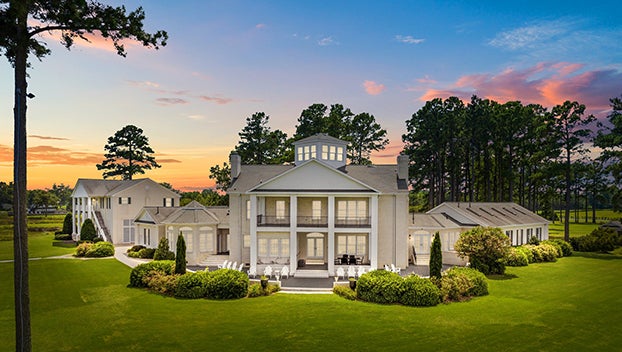Washington walking tour a historic experience
Published 6:55 pm Thursday, June 30, 2016

- HISTORICALLY SIGNIFICANT: Elmwood, built in 1820, is one of the most historically significant properties in Washington. It’s one of the homes on Washington’s Historic Walking Tour.
The Heart of the Inner Banks — that’s how visitors know Washington and greater Beaufort County. The main draws are, and always have been, the rivers here and the many opportunities to take a swim, a boat ride, do some fishing or watch a sunset over the water. Friends, family and tourists may come for a river adventure, but in those hours off the water, in the cool of evening, the thing to do is take a walk.
Washington has a long history and as the centuries have passed, many pieces of that history have disappeared. Others remain. And one can see them all on a leisurely stroll downtown.
A Brief History
English explorers visited the area as early as 1585; settlements first appeared in the 1690s, but it wasn’t until 1712 that the place on the Pamlico would be given a name: Beaufort, after Henry Somerset, the Duke of Beaufort. In the 1770s, the town that would become Washington was founded by Col. James Bonner, who donated land for public buildings, streets and a church. During the Civil War, much of the town burned to the ground as the Union Army fled; in 1900, the town would burn again. Much of the town’s late Victorian commercial architecture dates to rebuilding after the second fire. The City of Washington and organizations such as the Washington Area Historic Foundation are dedicated to the town’s historic preservation.

WEST MAIN GEM: The Grist-Rodman home is built on the former site of a shipbuilding business that was owned by a freed slave, Hull Anderson.
The Historic Walking Tour:
Drive down any downtown street, and one will see markers pointing out historically significant properties: homes, churches, courthouses and more. While Washington Tourism Development Authority printed beautifully bound guides for the walking tour, they proved so popular they ran out and it’s in the works to have them reprinted. The walking tour is divided into three districts; the homes listed here are located in the western district. For those in the mood for a stroll down Washington’s memory lane, the following are highlights of the tour. Happy walking!
1. Grist-Rodman House, Greek Revival, circa 1848
520 W. Main St.
This home was built on land that once held a successful shipbuilding business owned by a freed slave named Hull Anderson, who later immigrated to Liberia, Africa. The home is a fine example of Greek Revival style, with Doric-type posts and cast iron balustrade. Etched red Venetian glass panels on each side of the front door are original to the house. Home to two North Carolina Supreme Court Justices.
2. Greenhill, Greek Revival cottage, circa 1825
612 W. Main St.
The raised-basement Greek Revival Cottage once sat on a lot that sloped down a hill toward the river, thus its name. An old kitchen, housekeeper’s room and sewing room populate the basement level, and the home’s doors retained original hardware, some of which is stamped with an English crest.
3. Hollyday House, circa 1840
706 W. Second St.
When the Union Army left Washington during the Civil War, Hollyday House was one of the few structures to survive the fire. The antebellum home is thought to have been built in the mid-1800s by John Myers. The house was moved to its present location from a site closer to Second Street.
4. Elmwood, circa 1820
731 W. Main St.
In 1857, a writer for Harper’s Weekly described Elmwood as one of the South’s most distinguished homes. It was built by Col. Joshua Tayloe, and from its front lawn, the Confederate Washington Grays marched away to war in 1861. In 1910, it was moved from its original site at the end of West Main Street. The original configuration of the façade was in the Tidewater Virginia style with a two-story center section and one-story wings. Later modifications gave the home an Italianate flair.
5. Riverside-Winfield House, circa 1886
627 W. Main St.
Once The River Side hotel and depot for Washington’s first railroad, the Jamesville & Washington, affectionately known as the “Jolt and Wiggle,” half the home was moved to Jamesville to serve as that town’s depot. At one point a boarding house and then a school, the home was restored by Capt. and Mrs. George J. Studdert, who in 1900 planted the yard with some of the first pecan trees brought to Washington.
6. Dumay House, Queen Anne, circa 1901
603 W. Main St.
With stone carriage steps at the curb and a cast iron fence and fountain, this Queen Anne style home retains much of its original detailing, which includes several hidden panels. A.M. Dumay was associated with First National Bank.
7. Leach House, Colonial Revival, circa 1879
511 W. Main St.
Constructed by Fenner B. Satterthwaite and purchased by Eureka Lumber Company President George T. Leach in 1879, the home still retains its original leaded, beveled-glass windows. Boasting elaborate interior finishes, it’s a fine example of Colonial Revival style.





